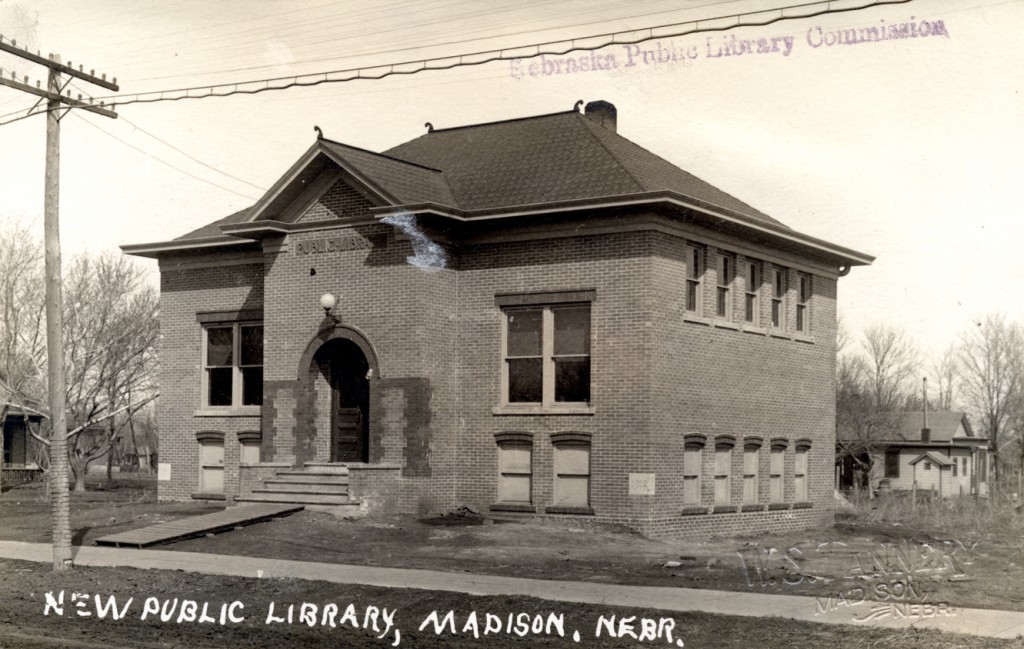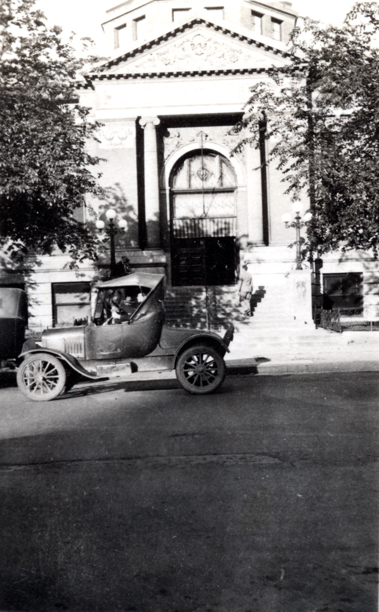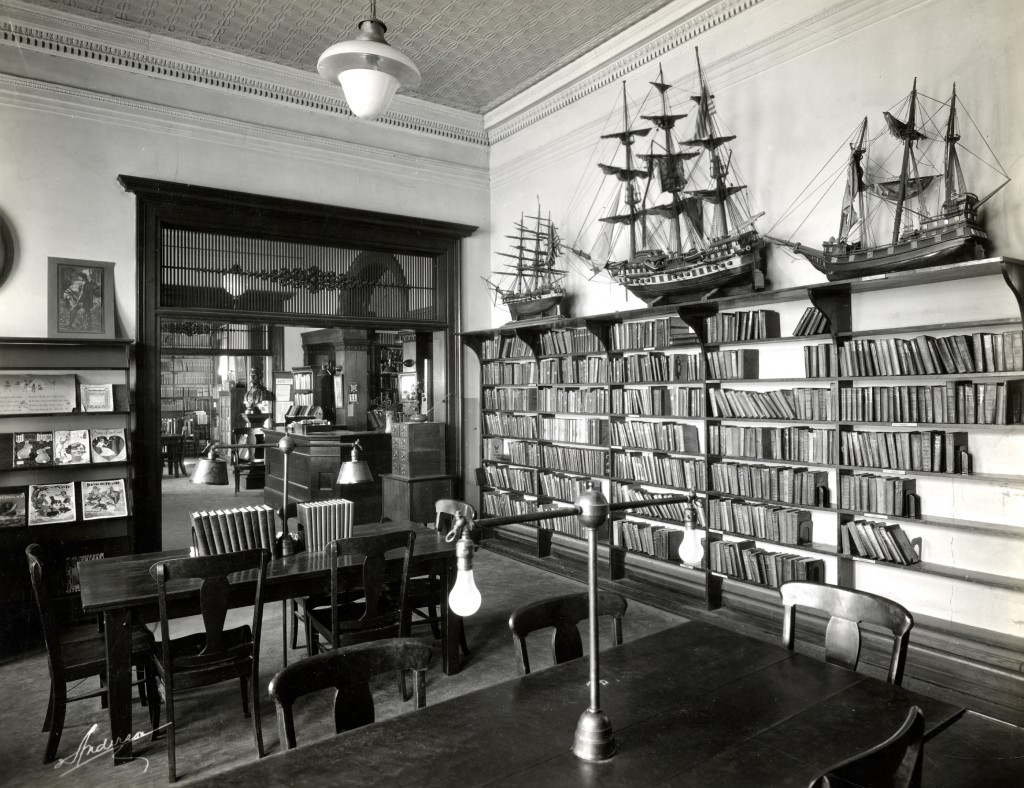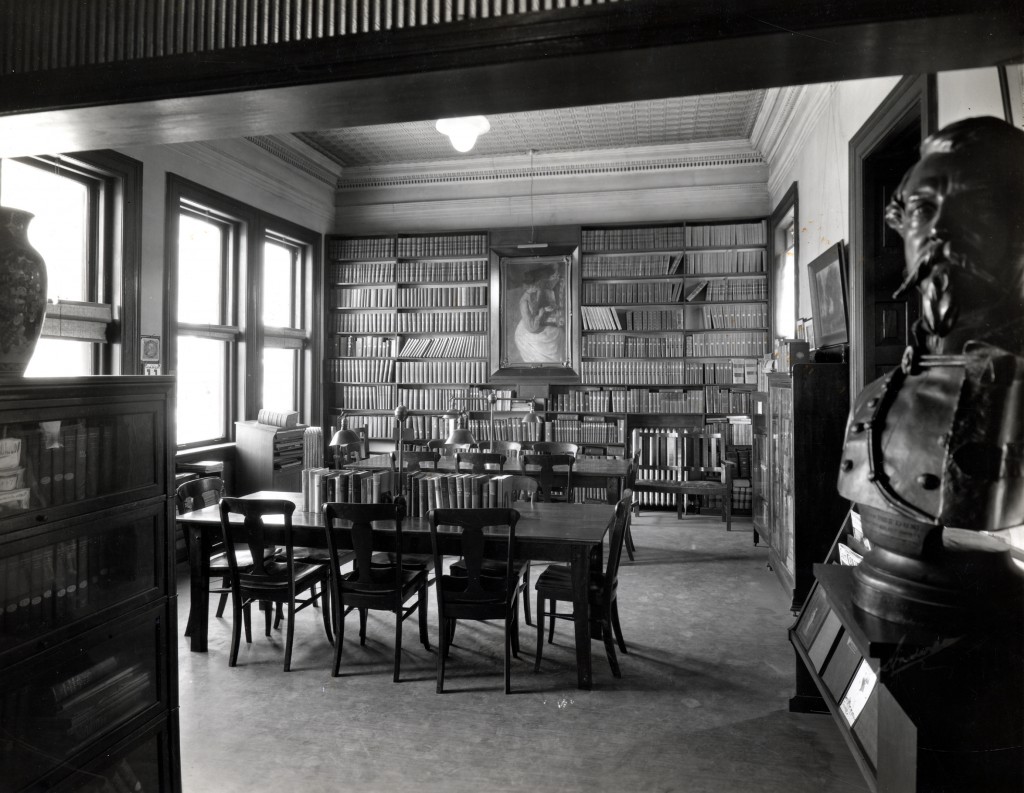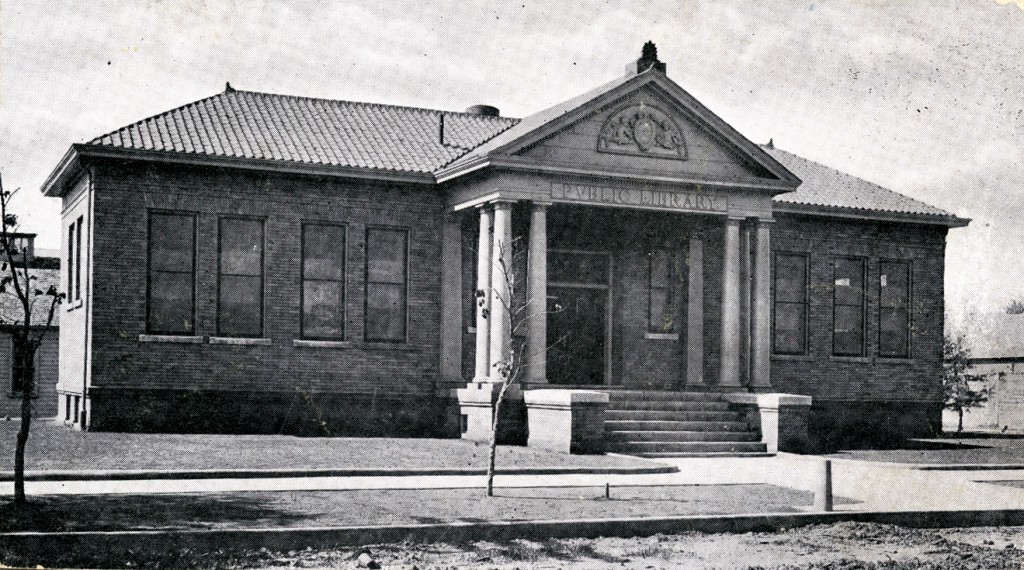Search the Blog
Categories
- Books & Reading
- Broadband Buzz
- Census
- Education & Training
- General
- Grants
- Information Resources
- Library Management
- Nebraska Center for the Book
- Nebraska Memories
- Now hiring @ your library
- Preservation
- Pretty Sweet Tech
- Programming
- Public Library Boards of Trustees
- Public Relations
- Talking Book & Braille Service (TBBS)
- Technology
- Uncategorized
- What's Up Doc / Govdocs
- Youth Services
Archives
Subscribe
Category Archives: General
Small Business Administration’s Video Series on Millennial Starts-Up Businesses
 The U.S. Small Business Administration’s My Brother’s Keeper Initiative unveiled this month the full line-up of the six successful millennial entrepreneurs featured in a new video series hosted by Mike Muse, the SBA MBK Millennial Entrepreneur Champion.
The U.S. Small Business Administration’s My Brother’s Keeper Initiative unveiled this month the full line-up of the six successful millennial entrepreneurs featured in a new video series hosted by Mike Muse, the SBA MBK Millennial Entrepreneur Champion.
The six-part video series, titled “Biz My Way,” encourages millennials to follow their passion in business and highlights millennial entrepreneurs from different professions ranging from technology to fashion and music.
The series features digital innovator Reggie Miller, technology investor Jason Mowatt, celebrity trainer Ehinomen “Hollywood Hino” Ehikhamenor, Being Latino founder Lance Rios, Chef Maxcel Hardy and Beyoncé’s stylist and designer Ty Hunter, who launched the series in November.
My Brother’s Keeper is President’s Obama’s initiative to empower young people, particularly young men of color, to improve their life outcomes and overcome barriers to success. The MBK Millennial Entrepreneurs Champion initiative formally began in June 2015, when SBA Administrator Maria Contreras-Sweet charged Mike Muse with establishing partnerships and joint collaborations with American companies that would elevate awareness around entrepreneurship. Additionally, he was tasked with developing programming to unite millennials with industry experts in an effort to help shift various lifestyle categories of business in a more inclusive direction.
Shot documentary style, each entrepreneur reveals their paths to entrepreneurship. In the first video, Ty Hunter revealed his transition from working in the healthcare industry to fashion. Hunter speaks candidly about his personal brand, his successes, his fears and his work with Beyoncé. https://youtu.be/oLK3A_UX85A
Upcoming MBK videos include:
Ehinomen Ehikhamenor – Released December 17, 2015
Ehinomen Ehikhamenor, known as “Hollywood Hino” is a Nigerian-born former professional boxer and personal trainer to a star-studded roster of athletes and recording artists. He shares his story about bypassing standard career options (doctor, lawyer, engineer) and a life-changing decision that led to a pursuit beyond the ring. https://youtu.be/EYyA27oXHDA
Lance Rios – Release Date January 6, 2016
Lance Rios is the founder of Being Latino a leading Hispanic social media marketing firm and who Forbes called “one of the Latino sphere’s most interesting innovators.” Lance shares how his knowledge of the bilingual, bicultural Latino population in the United States propelled him to start Being Latino – a passion project that ultimately turned into a full-fledged multi-million dollar company.
Reggie Miller – Release Date January 13, 2016
Reggie Miller is the founder of Iced Media and leads digital, social and mobile strategies for some of the industry’s most trusted brands and Fortune 500 companies. He reveals his secrets for creating a successful digital marketing firm.
Maxcel Hardy – Release Date January 20, 2016
Maxcel Hardy is a private chef, author and philanthropist who went from NBA hopeful to cooking for NBA players and the private aviation industry. Chef Max proves the recipe for success is part passion with a dash of belief and persistence.
Jason Mowatt – Release Date late January
Jason Mowatt is a millennial venture capitalist and former investor in the successful Trillectro music festival. His backing, coupled with his passion for technology and social media, helped position Trillectro as Washington, D.C.’s first music festival to bridge hip-hop, electronic, R&B and indie rock.
The “Biz My Way” video series is available on SBA.gov and www.BizMyWay.com, a multi-media, socially enabled, digital content platform that allows users to follow the day-to-day journey of Mike Muse and the initiative.
ABOUT THE MY BROTHER’S KEEPER MILLENNIAL ENTREPRENEUR CHAMPION
On June 19, 2015, Mike Muse was appointed as the SBA My Brother’s Keeper Millennial Entrepreneur Champion. Together, with the U.S. Small Business Administration, Muse will provide education, exposure, support, and coaching to help entrepreneurs create businesses that benefit themselves and enrich their communities. Learn more at www.BizMyWay.com.
ABOUT THE U.S. SMALL BUSINESS ADMINISTRATION (SBA)
The U.S. Small Business Administration (SBA) was created in 1953 as an independent agency of the federal government to aid, counsel, assist and protect the interests of small business concerns, to preserve free competitive enterprise and to maintain and strengthen the overall economy of our nation. The SBA helps Americans start, build and grow businesses. Through an extensive network of field offices and partnerships with public and private organizations, the SBA delivers its services to people throughout the United States, Puerto Rico, the U.S. Virgin Islands and Guam. www.sba.gov.
The Data Dude: Charts of 2015
 As 2015 comes to an end, it’s time to show some of the most misleading charts of the year. This serves multiple purposes; a bit of comic relief and to illustrate how a much more cogent display of the data would have looked (the link below shows both the misleading charts and then fixes to them). While the Dude would like to say that he compiled this list; instead kudos goes out to Keith Collins from Quartz, a digitally native news outlet. According to the Quartz website, they publish “bracingly creative and intelligent journalism with a broad worldview, built primarily for the devices closest at hand: tablets and mobile phones.” Keith’s article is called Axis of Evil: The most misleading charts of 2015, fixed. Shaka, Keith.
As 2015 comes to an end, it’s time to show some of the most misleading charts of the year. This serves multiple purposes; a bit of comic relief and to illustrate how a much more cogent display of the data would have looked (the link below shows both the misleading charts and then fixes to them). While the Dude would like to say that he compiled this list; instead kudos goes out to Keith Collins from Quartz, a digitally native news outlet. According to the Quartz website, they publish “bracingly creative and intelligent journalism with a broad worldview, built primarily for the devices closest at hand: tablets and mobile phones.” Keith’s article is called Axis of Evil: The most misleading charts of 2015, fixed. Shaka, Keith.
Posted in General, Library Management, Uncategorized
Leave a comment
Great Books for Starting A Small Business
 Are your patrons asking for books about starting a new or small business? The December issue of Library Journal has a great article full of useful resources, complete with reviews. The books on this list are of interest to anyone starting a small company.
Are your patrons asking for books about starting a new or small business? The December issue of Library Journal has a great article full of useful resources, complete with reviews. The books on this list are of interest to anyone starting a small company.
There’s still time to get Health Care coverage for 2016!
 Good news! Although the December 17 deadline to enroll in a health plan for coverage starting in January has passed, you still have time to get coverage starting February 1.
Good news! Although the December 17 deadline to enroll in a health plan for coverage starting in January has passed, you still have time to get coverage starting February 1.
Join the millions who have already picked their 2016 plans. Just select your state, and you’re on your way to submitting your application for 2016.
Get covered and save: 8 out of 10 people who enrolled in a health insurance plan qualified for financial help. In fact, most people can find plans for $75 or less per month.
Don’t miss your chance to get quality coverage — enroll in a 2016 plan today!
Deadline: January 15, 2016 for coverage starting February 1 at HealthCare.gov
The Data Dude: Digital Inclusion Survey Update
 Many of you are familiar or participated in last year’s digital inclusion survey. For those of you who might be new and have not heard about this, please check it out. Now the website can be a bit difficult to navigate, so let’s try and point out a couple of valuable things. While it is certainly encouraged to browse around the site, a good starting point is the interactive map. Recently, the digital inclusion people put a note towards the top of the mapping tool indicating a number of changes to the data, various “enhancements”, and the ability for you to update your own data. The easiest way to get started is to scroll down on the map page to the actual map, and directly above the map is a search box (called library lookup) for your library name (keep in mind that this is the name of the library, not necessarily your city). You can also use one of the draw tools to select a custom area on the map. Once you locate your library from the library lookup feature, the search will retrieve a map on the left and various folders on the right that summarize the following areas (with data pulled from census): Demographics, Economics, Education, Health, and Survey. While this is the same stuff you can get from Census, arguably this might be a more decent starting point or overview of data to better know your library service area. One other thing worth mentioning is that if you click on the map marker for your library you will get a pop-up that summaries the specific digital inclusion data for your library (or library branch). This includes the number of public access computers, broadband speed, technology services/resources, training, and programs/assistance. Underneath the google map photo on the left side of this pop-up, you can change the demographic radius (from 1, 3, 5, or 10 miles), export a summary profile of your library to a PDF (e.g. to hand out to board members, local policy makers, or members of the community), or edit your survey information. If things have changed, please update your information so that the maps are kept up to date. You can do this by clicking on the “Edit Branch & Survey Info” bar (again, just below the google map photo of your library, or the street in front of your library). Shaka.
Many of you are familiar or participated in last year’s digital inclusion survey. For those of you who might be new and have not heard about this, please check it out. Now the website can be a bit difficult to navigate, so let’s try and point out a couple of valuable things. While it is certainly encouraged to browse around the site, a good starting point is the interactive map. Recently, the digital inclusion people put a note towards the top of the mapping tool indicating a number of changes to the data, various “enhancements”, and the ability for you to update your own data. The easiest way to get started is to scroll down on the map page to the actual map, and directly above the map is a search box (called library lookup) for your library name (keep in mind that this is the name of the library, not necessarily your city). You can also use one of the draw tools to select a custom area on the map. Once you locate your library from the library lookup feature, the search will retrieve a map on the left and various folders on the right that summarize the following areas (with data pulled from census): Demographics, Economics, Education, Health, and Survey. While this is the same stuff you can get from Census, arguably this might be a more decent starting point or overview of data to better know your library service area. One other thing worth mentioning is that if you click on the map marker for your library you will get a pop-up that summaries the specific digital inclusion data for your library (or library branch). This includes the number of public access computers, broadband speed, technology services/resources, training, and programs/assistance. Underneath the google map photo on the left side of this pop-up, you can change the demographic radius (from 1, 3, 5, or 10 miles), export a summary profile of your library to a PDF (e.g. to hand out to board members, local policy makers, or members of the community), or edit your survey information. If things have changed, please update your information so that the maps are kept up to date. You can do this by clicking on the “Edit Branch & Survey Info” bar (again, just below the google map photo of your library, or the street in front of your library). Shaka.
Become an E-Learning Information Professional
Become an E-Learning Information Professional
Beginning Spring 2016: Program specialization in e-learning for information professionals. Librarians are being tasked to learn and use many new technologies, bridging information resources and instructional design. The E-Learning Information Professional specialization meets that need, drawing from the entirety of University of Missouri School of Information Science & Learning Technology curriculum.
Courses in the specialization will be 100% online.
Graduates will be prepared to work in environments across the entire range of librarianship:
• K-12, public, academic, and special libraries
• corporate
• non-profit
• government
• military
MU’s Library and Information Science program is fully accredited by the American Library Association (ALA), and is the ONLY accredited LIS program in the state of Missouri. Contact: For more information on the E-Learning Information Professional Specialization within the LIS program, email Jenny Bossaller (bossallerj@missouri.edu).
See the announcement at sislt.missouri.edu for more information on coursework options.
Posted in Education & Training, General
Leave a comment
The Data Dude – Wednesday Watch: Super Hero Squad Show
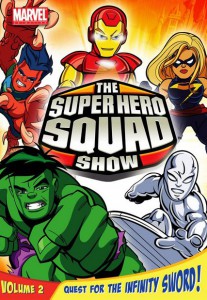 Today’s Wednesday Watch will be about the animated Super Hero Squad Show. Depending on the season, 2-3 Nebraska libraries have the Super Hero Squad Show on DVD. The characters, a rather large collection of Marvel super heroes, are drawn in a mini-version, similar to that of Chibi (a style of Japanese anime where characters are drawn in child-like fashion with oversized heads). For lack of a more appropriate synonym, they are, well, kind of cute. The main characters all have their own little bits of quirkiness which makes the show worthwhile, transcending the same ol’ good fighting evil story. For example, suave Iron Man is complicated and tech-saavy, albeit a bit too impulsive; Hulk is simple minded, strong, and of course has anger management issues that affect the rest of the group; Silver Surfer, while an alien, talks quite like a stereotypical surfer; Thor speaks in an Olde English tongue; Wolverine likes it cold and uses his claws to carve topiaries, just like Edward Scissorhands; Ms. Marvel is strong but temperamental at times. Not to mention a whole host of supporting characters that appear, including the recurring villains. Stan Lee is the mayor of Super Hero City. In addition to Ms. Marvel, female characters are represented by Black Widow, Storm, the Wasp, Scarlet Witch, and others.
Today’s Wednesday Watch will be about the animated Super Hero Squad Show. Depending on the season, 2-3 Nebraska libraries have the Super Hero Squad Show on DVD. The characters, a rather large collection of Marvel super heroes, are drawn in a mini-version, similar to that of Chibi (a style of Japanese anime where characters are drawn in child-like fashion with oversized heads). For lack of a more appropriate synonym, they are, well, kind of cute. The main characters all have their own little bits of quirkiness which makes the show worthwhile, transcending the same ol’ good fighting evil story. For example, suave Iron Man is complicated and tech-saavy, albeit a bit too impulsive; Hulk is simple minded, strong, and of course has anger management issues that affect the rest of the group; Silver Surfer, while an alien, talks quite like a stereotypical surfer; Thor speaks in an Olde English tongue; Wolverine likes it cold and uses his claws to carve topiaries, just like Edward Scissorhands; Ms. Marvel is strong but temperamental at times. Not to mention a whole host of supporting characters that appear, including the recurring villains. Stan Lee is the mayor of Super Hero City. In addition to Ms. Marvel, female characters are represented by Black Widow, Storm, the Wasp, Scarlet Witch, and others.
The side stories are what make the Super Hero Squad Show interesting. True, the way the characters are drawn is unique, but without a decent and creative storyline, this show would fail. It doesn’t, however (fail that is). The heroes do mundane things that one wouldn’t expect, such as engage in philosophical discussions, fight over the remote control, bicker about whom should clean things up (and household messes in general), and numerous references to pop culture. And those things are funny. Sure, there are juvenile potty type jokes, but nothing too over the top. If your library is looking for something to appeal to the young crowd that won’t be too tough on adults who might be sitting in, Super Hero Squad Show might fit the bill. Warning: the theme song will stick in your head, so watch out. Speaking of the theme song, a recurring notion that appears in the song and the show is the term “Hero Up!” Whenever the “squaddies” (that’s what they are called) are faced with an adverse situation or villainous infiltration, they use the phrase “It’s time to Hero Up!” If you watch the show enough, you may find this translate over to the other parts of your life. A few examples: Kids not motivated to clean their room? Tell them it’s time to Hero Up. Richard promised stats for the Dude last week but hasn’t gotten it done yet? Hey Richard: Time to Hero Up. You get the idea. Special thanks to the Shout! Factory folks for the permission to use the SHS cover art. Shaka.
Posted in General, Library Management, Uncategorized
Leave a comment
Public Libraries Able to Access Nebraska Supreme Court and Court of Appeals Opinions Through Public Website
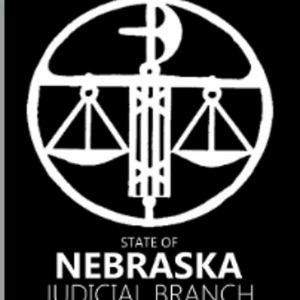 Free online access to the official published judicial opinions of the Nebraska Supreme Court and Nebraska Court of Appeals will be available to the public beginning January 1, 2016.
Free online access to the official published judicial opinions of the Nebraska Supreme Court and Nebraska Court of Appeals will be available to the public beginning January 1, 2016.
Text-searchable opinions dating back to 1871 will be available for the Nebraska Supreme Court. The full collection of opinions of the Nebraska Court of Appeals, beginning with its establishment in 1992, will also be offered.
Previously, appellate court opinions were printed or were available online through various for-profit subscription services. All published opinions will be provided via the Nebraska Appellate Courts Online Library at ne.gov/go/opinions. Once printing of judicial opinions in the Nebraska Advance Sheets and the Decisions of the Nebraska Court of Appeals ceases in June 2016, opinions will be available exclusively online.
Newly released opinions of both courts will continue to be available for 90 days on the Nebraska Judicial Branch Web site at https://supremecourt.nebraska.gov/ and from the Clerk of the Supreme Court and Court of Appeals upon request, and from any electronic provider of legal information choosing to provide them.
Official opinions in the online library will be accessible 24/7 using smart phones, tablets or computers from anywhere with Internet access. Access via the online library allows the appellate courts to make their judicial opinions more easily available to the public.
Community College LIS Courses Start Jan. 11
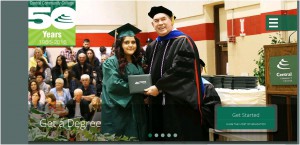
Register Now for Online Library & Information Services Courses through Central Community College
Online Course Offerings: January 11, 2016 – May 5, 2016
LIBR 2150 Managing Collections in Libraries and Information Agencies,
Patty Birch, Instructor
This course will provide students with an understanding of managing collections in libraries and information agencies, including:
- Basics of Collection Management (terminology, models)
- 21st Century Literacies
- Selection (All resources, for all age levels)
- Acquisition
- Deselection/Weeding
- Intellectual Freedom
- Copyright
Suggested prerequisite: LIBR 1010 Foundations of Library & Information Services. For information regarding course content, contact the instructor: Patty Birch, pbirch@cccneb.edu
LIBR 2210 Cataloging and Classification, Ruth Carlock, Instructor
This course will include theories, concepts and activities for cataloging and classifying materials in the 21st Century. It includes the following topics:
- The bibliographic record
- Sears and Library of Congress subject headings
- Dewey Decimal and Library of Congress classification systems
- The MARC record
- Resource Description and Access Instructions
Suggested prerequisite: LIBR 1010 Foundations of Library & Information Services
For information regarding this course, contact the instructor: Ruth Carlock, rcarlock@cccneb.edu
For information concerning Admissions or Registration, contact: Dee Johnson, djohnson@cccneb.edu, 402-562-1418 or 877-222-0780 ext. 1418.
Nebraska Library Commission Announces Accreditation for Public Libraries
FOR IMMEDIATE RELEASE:
December 15, 2015
FOR MORE INFORMATION:
Richard Miller
402-471-3175
800-307-2665
Nebraska Library Commission Announces Accreditation for Public Libraries
Nebraska Library Commission Library Development Director Richard Miller recently announced the accreditation of public libraries across Nebraska. Miller stated, “We are dedicated to helping Nebraska libraries meet Nebraskans’ information needs, opening up the world of information for citizens of all ages. The Library Commission continues to work in partnership with Nebraska libraries and the regional library systems, using the Public Library Accreditation program to help public libraries grow and develop.”
Public libraries in Nebraska are accredited for a three-year period, from October 1 of the first year, through September 30 of the third year. To learn more about this process, and see a complete list of all accredited Nebraska libraries, see the Nebraska Library Commission website (nlc.nebraska.gov), search on Accreditation.
The Nebraska Library Commission congratulates the public libraries listed below as they move forward toward the realization of this vision for the future: “All Nebraskans will have improved access to enhanced library and information services, provided and facilitated by qualified library personnel, boards, and supporters with the knowledge, skills, abilities and attitudes necessary to provide excellent library and information services.”
As the state library agency, the Nebraska Library Commission is an advocate for the library and information needs of all Nebraskans. The mission of the Library Commission is statewide promotion, development, and coordination of library and information services, “bringing together people and information.”
Nebraska Public Libraries Newly Accredited through September 30, 2018
Ainsworth Public Library
Alliance Public Library
Auburn Memorial Library
Aurora, Alice M Farr Library
Bassett, Rock County Public Library
Beatrice Public Library
Beaver City Public Library
Beemer, Karlen Memorial Library
Bellevue Public Library
Bennington Public Library
Bloomfield Public Library
Blue Hill Public Library
Broadwater Public Library
Broken Bow Public Library
Central City Public Library
Clarkson Public Library
Clearwater Public Library
Creighton Public Library
Crete Public Library
Culbertson Public Library
David City, Hruska Memorial Public Library
DeWitt, Bob and Wauneta Burkley Library and Resource Center
Emerson Public Library
Exeter Public Library
Fairbury Public Library
Fairmont Public Library
Friend, Gilbert Public Library
Genoa Public Library
Gering Public Library
Gibbon Public Library
Gordon City Library
Gothenburg Public Library
Grand Island Public Library
Gretna Public Library
Hartington Public Library
Hildreth Public Library
Holdrege Area Public Library
Hooper Public Library
Hyannis, Grant County Library
Lied Imperial Public Library
Kimball Public Library
La Vista Public Library
Lexington Public Library
Lincoln City Libraries
Loup City Public Library
Madison Public Library
McCook Public Library
Minden, Jensen Memorial Library
Mitchell Public Library
Nebraska City, Morton-James Public Library
Newman Grove Public Library
Norfolk Public Library
North Platte Public Library
Oakland Public Library
Omaha Public Library
O’Neill Public Library
Ord Township Library
Orleans, Cordelia B Preston Memorial Library
Oshkosh Public Library
Palisade Public Library
Papillion, Sump Memorial Library
Pilger Public Library
Plainview Carnegie Library
Plattsmouth Public Library
Schuyler Public Library
Lied Scottsbluff Public Library
Scribner Public Library
Seward Memorial Library
South Sioux City Public Library
Stanton Public Library
Stromsburg Public Library
Superior Public Library
Lied Tekamah Public Library
Raymond A Whitwer Tilden Public Library
Valentine Public Library
Wausa, Lied Lincoln Township Library
Wayne Public Library
Weeping Water Public Library
West Point, John A Stahl Library
Wilber, Dvoracek Memorial Library
Wymore Public Library
Yutan Public Library
###
The most up-to-date news releases from the Nebraska Library Commission are always available on the Library Commission Website, http://nlc.nebraska.gov/publications/newsreleases.
Throwback Thursday: Kearney Carnegie Library
Interior photo of the children’s reading room at the Kearney, Nebraska Carnegie Library built in 1905.
Posted in General, Nebraska Memories
Leave a comment
The Data Dude on Line Charts, Pt. 2
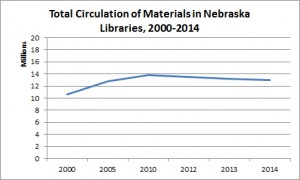
 Last week, in response to some data about paper book holdings in Nebraska libraries, the Dude asked the question: So what? Today will be an attempt to provide some context. If we look at the title to last week’s NET line graph, Bill Kelly added the following label to the top of the graph: SHELF LIFE: Fewer Library Books, and of course the assumption is that libraries have fewer paper books, presumably in response to less demand, and more eBooks. And over the time period in the NET graph (2010-2014) that’s true. But as was mentioned last week, if the data is expanded back to 2000, there was an actual increase of 1.19% in paper book holdings in Nebraska libraries during those 14 years, but the trend over the past few years is in fact lower amounts of physical items and increased amounts of electronic items in libraries.
Last week, in response to some data about paper book holdings in Nebraska libraries, the Dude asked the question: So what? Today will be an attempt to provide some context. If we look at the title to last week’s NET line graph, Bill Kelly added the following label to the top of the graph: SHELF LIFE: Fewer Library Books, and of course the assumption is that libraries have fewer paper books, presumably in response to less demand, and more eBooks. And over the time period in the NET graph (2010-2014) that’s true. But as was mentioned last week, if the data is expanded back to 2000, there was an actual increase of 1.19% in paper book holdings in Nebraska libraries during those 14 years, but the trend over the past few years is in fact lower amounts of physical items and increased amounts of electronic items in libraries.
The eBook conundrum is a difficult one, and analyzing data for library holdings of eBooks is hard to illustrate. Why? Well, a few reasons, including the fact that eBooks aren’t technically purchased by libraries, they are leased. And those lease terms vary by publisher (both the duration and the price). Some publishers still don’t make electronic copies of their books available to libraries at all. Perhaps that is the deeper story to something like SHELF LIFE: Fewer Library Books; namely how the eBook lending platforms for libraries are much different than the traditional right of first sale traditional paper model. Notwithstanding all of this, it might be more productive to look at trends about the actual use of the items in the library collection. And even that might be misleading; a library could contain a bunch of crap that no one wants to check out, but for one reason or another has never been weeded. When a new go-getter takes over the library, perhaps all this lower demand stuff gets weeded and replaced with stuff that actually will be used. The end result to that would be lower numbers of paper books and VHS tapes (assuming those are the ones that would be weeded), and increased circulation of other things like light sabers and power tools. The chart, above right, demonstrates the total circulation of items in Nebraska over the last 14 years (incidentally, while the one above has the Y-axis at zero, it doesn’t look remarkably different when the Y-axis is started at 5 million).
The reality is that overall in the state, circulation of electronic items went up about 80% from 2012-2014, and circulation of physical items declined 6.42% during the same time period. Much of this is due to the fact that more libraries got involved in consortia (such as Nebraska OverDrive) that allowed more communities (and thus overall more people) to access materials. Keep in mind that, notwithstanding the recent decline of physical items held by Nebraska libraries, over 12 million physical items did circulate in 2014 (more than 15 times the number of electronic items used). Therefore, when looking at these numbers, many times the debate is framed as an either/or proposition when it comes to the physical and electronic in libraries (such as part 5 of the NET series – Will a Nebraska Community Tech Center Force Us To Consider Libraries Without Books?) and ultimately that’s probably not the question to ask (at least the data doesn’t support it).
In actuality, libraries are offering new things and expanding services in addition to offering the traditional ones. As the chart second from the top illustrates, program attendance has gone up during the 2000-2014 time period. Additionally, the number of programs offered has risen at a rate fairly consistent with program attendance, and annual library visits have remained fairly steady for a number of years at around 8 million per year. The real questions (and the NET series tackled some of these) are how libraries are adapting to meet the needs of the community, by either expanding the offering of things in the collection, programs, and spaces (which admittedly is broad ranging, and could mean things like meeting rooms, community learning spaces, or collaborative makerspaces). And that is why the real question should be framed by an “and” instead of an “or”. Shaka.
New Makerspace Page!
Check out the Nebraska Library Commission’s newest page: Creative, Innovative, and MakerSpaces in Nebraska! Here we list Nebraska libraries that have purchased 3D printers, as well as public and private “creative spaces” throughout the state – places you can visit to take classes, work with technology, make art, write poetry – whatever your creative outlet, we want to help you find a space for it!
This page is a work-in-progress and will be constantly updated as we discover more resources. If you have, or know of, a space we have not listed, please contact the Information Services Team.
Posted in General, Information Resources
2 Comments
Apply for Internship Grants by Dec. 17
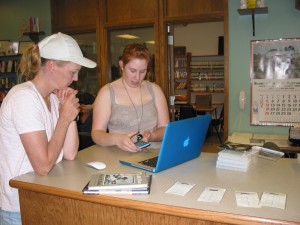 Two weeks left for Accredited Public Libraries to submit a 2016 Nebraska Library Internship Grant application to receive up to $1,000 to fund a high school or college intern in 2016! The final deadline to submit your application is Thursday, December 17 at 5:00 p.m. Interns bring a wealth of ideas and enthusiasm to Nebraska library services–and as you can see in the attached photo, they are often invaluable as technology mentors for library customers.
Two weeks left for Accredited Public Libraries to submit a 2016 Nebraska Library Internship Grant application to receive up to $1,000 to fund a high school or college intern in 2016! The final deadline to submit your application is Thursday, December 17 at 5:00 p.m. Interns bring a wealth of ideas and enthusiasm to Nebraska library services–and as you can see in the attached photo, they are often invaluable as technology mentors for library customers.
Details about the 2016 Nebraska Library Internship Grant Program are available at: https://nlc.nebraska.gov/nowhiring/Internship-grants.aspx For more information contact: JoAnn McManus, Grants Program Manager, 402-471-4870 or 800-307-2665.
Free Resources Seminar to start and grow your small business
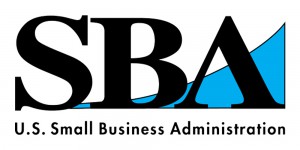 Do you have a great idea for a business but just don’t know where to begin? Knowing where to go to get help is crucial to starting and/or growing your small business. In this seminar, you will learn about a variety of free and low-cost resources to help you: write your business plan, find training opportunities, receive small business counseling and mentorship, obtain legal guidance, learn about networking opportunities, benefit from free online education, and learn about all kinds of other resources.
Do you have a great idea for a business but just don’t know where to begin? Knowing where to go to get help is crucial to starting and/or growing your small business. In this seminar, you will learn about a variety of free and low-cost resources to help you: write your business plan, find training opportunities, receive small business counseling and mentorship, obtain legal guidance, learn about networking opportunities, benefit from free online education, and learn about all kinds of other resources.
Free resources include SCORE, the Nebraska Business Development Center and REAP’s Women’s Business Center.
Greater Omaha Chamber of Commerce
1301 Harney Street, Omaha, Neb.
Tuesday, Dec 8th from 12-1 p.m.
Email elizabeth.yearwood@sba.gov to register
The Data Dude on Line Charts, Pt. 1

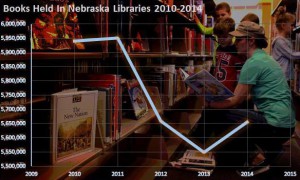
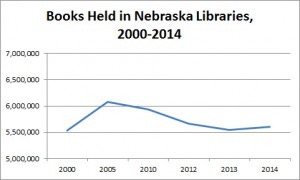
 Today’s post will focus on line charts (or graphs, if you prefer). The Dude thought about this in response to the graph (second from the top, on the right) that NET posted on its website to supplement the recent 5 part LIBRARIES: The Next Chapter series. At first, the Dude took note of the Y-axis of the NET chart (it’s the one with the books and readers in the background), remembering some rule that says to always start these charts (and bar charts for that matter) with 0. So today’s post will take a look at the line chart and axes, and next week’s post will most likely take a closer look at this data and something called context. Note that the data from these charts is from the annual public library survey.
Today’s post will focus on line charts (or graphs, if you prefer). The Dude thought about this in response to the graph (second from the top, on the right) that NET posted on its website to supplement the recent 5 part LIBRARIES: The Next Chapter series. At first, the Dude took note of the Y-axis of the NET chart (it’s the one with the books and readers in the background), remembering some rule that says to always start these charts (and bar charts for that matter) with 0. So today’s post will take a look at the line chart and axes, and next week’s post will most likely take a closer look at this data and something called context. Note that the data from these charts is from the annual public library survey.
In 1954, Darrell Huff wrote a book called How to Lie with Statistics. One of the main takeaways of Huff’s book is the notion that bar and line charts should always start the Y-axis with 0. Anything other than 0 is a fabrication or at least a misrepresentation, according to Huff. The Dude created the first chart, top right, which illustrates the same data that appears on the NET chart. The only difference is the Y-axis starting at zero on the top chart, and 5.5 million on the bottom chart. Both charts illustrate an overall decline of 5.67% in paper book holdings from 2010-2014, or a decline of 6.56% from 2010-2013, and an increase of .95% from 2013-2014. Taking into consideration the differences in both of these charts, which one is a better illustration of the data? Well, maybe neither one of them.
The Dude is a huge fan of data statistician Nathan Yau. If you haven’t seen some of his data visualizations on FlowingData, check them out. So for this general question, namely, should the Y-axis always start at zero, the Dude consulted Nathan Yau. Ironically, Nathan’s FlowingData website had a post on the main page about this very topic, and if you have a chance, the Vox video he links to in his article is well worth the two and a half minutes. The gist is that the Y-axis need not always be zero, but the most important thing, as the Vox video illustrates, is context.
Originally, the Dude admits that he thought that the NET chart misrepresented the decrease in paper books held by Nebraska libraries (by illustrating a much larger decrease than actually occurred), but isn’t the increase illustrated from 2013-2014 just as misleading, since it tends to show a sharp and somewhat dramatic increase from 2013-2014 when in actuality the figure is less than 1%? Also, does the first graph at the top fail, in that it doesn’t show any change at all, or very little? If we expand the data back to 2000, we get a different illustration of the trend (see third and fourth right, with two different Y-axes). The real question here, generally speaking, after looking at the data, is the greatest of all philosophical questions: So what? That’ll hopefully be the topic for next week. Shaka.
